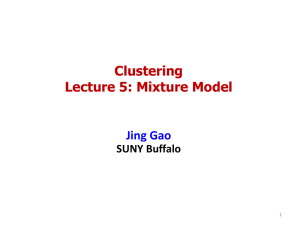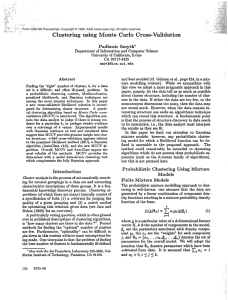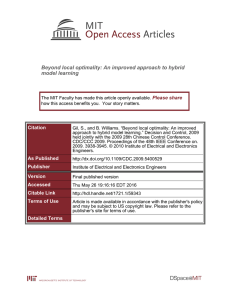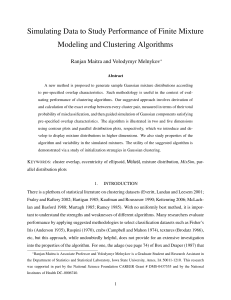Clustering Lecture 5: Mixture Model Jing Gao
advertisement
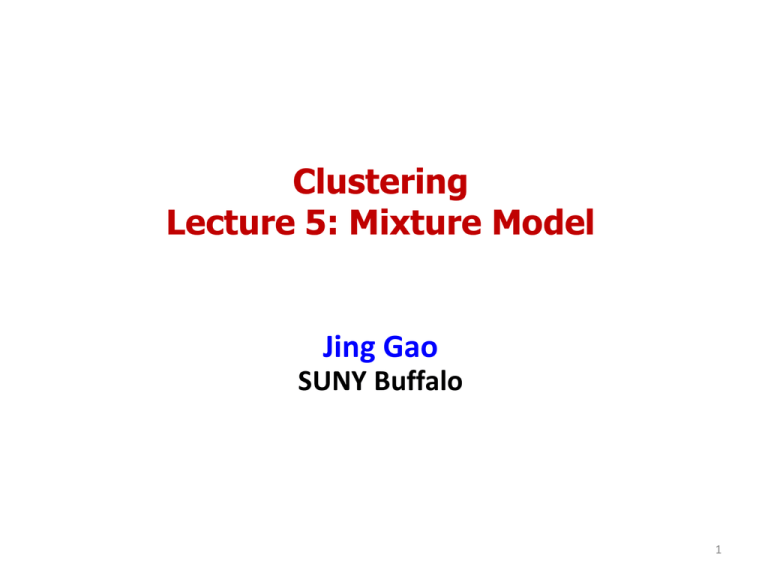
Clustering Lecture 5: Mixture Model Jing Gao SUNY Buffalo 1 Outline • Basics – Motivation, definition, evaluation • Methods – – – – – Partitional Hierarchical Density-based Mixture model Spectral methods • Advanced topics – Clustering ensemble – Clustering in MapReduce – Semi-supervised clustering, subspace clustering, co-clustering, etc. 2 Using Probabilistic Models for Clustering • Hard vs. soft clustering – Hard clustering: Every point belongs to exactly one cluster – Soft clustering: Every point belongs to several clusters with certain degrees • Probabilistic clustering – Each cluster is mathematically represented by a parametric distribution – The entire data set is modeled by a mixture of these distributions 3 Gaussian Distribution f(x) Changing μ shifts the distribution left or right σ μ Changing σ increases or decreases the spread x Probability density function f(x) is a function of x given μ and σ 1 1 x 2 2 N ( x | , ) exp( ( ) ) 2 2 4 Likelihood Which Gaussian distribution is more likely to generate the data? f(x) x Define likelihood as a function of μ and σ n given x1, x2, …, xn 2 N ( x | , ) i i 1 5 Gaussian Distribution • Multivariate Gaussian covariance mean • Log likelihood n n 1 L( , ) ln N ( xi | , ) ( ( xi )T 1 ( xi )) ln | |) 2 i 1 i 1 6 Maximum Likelihood Estimate • MLE – Find model parameters , that maximize log likelihood L( , ) • MLE for Gaussian 7 Gaussian Mixture • Linear combination of Gaussians where parameters to be estimated 8 Gaussian Mixture • To generate a data point: – first pick one of the clusters with probability – then draw a sample from that cluster distribution 9 Gaussian Mixture • Maximize log likelihood • Each data point is generated by one of K clusters, a latent variable is associated with each • Regard the values of latent variables as missing 10 Expectation-Maximization (EM) Algorithm • E-step: for given parameter values we can compute the expected values of the latent variables – Note that instead of but we still have 11 Expectation-Maximization (EM) Algorithm • M-step: maximize the expected complete log likelihood • Parameter update: 12 EM Algorithm • Iterate E-step and M-step until the log likelihood of data does not increase any more. – Converge to local optimal – Need to restart algorithm with different initial guess of parameters (as in K-means) • Relation to K-means – Consider GMM with common covariance – As , two methods coincide 13 14 14 15 15 16 16 17 17 18 18 19 19 K-means vs GMM • Objective function – Minimize sum of squared error • Can be optimized by an EM algorithm – E-step: assign points to clusters – M-step: optimize cluster centers – Performs hard assignment during E-step • Assumes spherical clusters with equal probability of a cluster • Objective function – Maximize log-likelihood • EM algorithm – E-step: Compute posterior probability of membership – M-step: Optimize parameters – Perform soft assignment during E-step • Can be used for non-spherical clusters • Can generate clusters with different probabilities 20 Mixture Model • Strengths – Give probabilistic cluster assignments – Have probabilistic interpretation – Can handle clusters with varying sizes, variance etc. • Weakness – Initialization matters – Choose appropriate distributions – Overfitting issues 21 Take-away Message • • • • Probabilistic clustering Maximum likelihood estimate Gaussian mixture model for clustering EM algorithm that assigns points to clusters and estimates model parameters alternatively • Strengths and weakness 22
